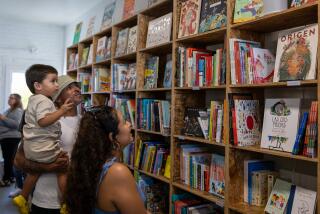Library Celebrating Diversity as a Resource : Culture: A special collection houses material on Americans of many races, bilingual education, special education and women’s issues.
- Share via
ALBUQUERQUE, N.M. — Joe Gonzales says his multicultural library has a little bit of everything, from Arikara to Zuni. And it’s a little bit of everything that usually can’t be found in an average library.
The Multicultural and Gender Equity Resource Library at the University of New Mexico is filled with materials about and from American Indian tribes.
The collection also contains materials on Latinos, blacks, bilingual education, counseling and guidance, special education and women’s issues, particularly sexual harassment.
“It’s a very, very strong diverse collection,” says Gonzales, the library’s founder and director.
The collection is housed at the College of Education. It includes 10,000 to 11,000 books, pamphlets, reprints of articles, teaching guides, kits and games, music and other audio tapes, videotapes and films.
Some is geared toward teachers or parents; others items were developed especially for students, from the very early grades through high school and college. “The idea is to get a discussion going, make them think,” says Gonzales.
The Indian collection is especially valuable because of the material put together by tribes--sometimes in their native languages. The library has material in 38 Indian languages running the gamut from Navajo and Seminole to Qawalangim (Aleut) and Arikara.
“These were developed by small Indian communities in their own language. Some is translated into English; some is not. But it’s not something you can find in the Library of Congress,” Gonzales says.
Gonzales, who worked for the Dallas Public Library for a decade, began what’s now the multicultural library more than 10 years ago. As a librarian, he says, he couldn’t help gathering information from tribes in the Southwest and the Dakotas as he traveled around.
He’s particularly proud of a collection of Navajo reading material in the Navajo language that he bought in 1977. The material, which fills several shelves, is out of print.
Many of those who use the library are teachers, teachers-to-be, parents and school districts. But Gonzales says he hears more and more from other universities wanting to know how to start a multicultural library as they revise and broaden courses to add minority and non-Western cultures.
Material from tribes makes up about a third of the Indian collection. It includes language texts, information gathered to show teachers how to use native material, legends, stories and short fiction.
Other items deal with Indian contributions in government, education, fine arts, language and agriculture. There’s also a small collection on tribal laws and federal laws as they apply to Indians.
One of the library’s most popular handouts compares traditional tribal cultural values with middle-class urban non-Indian values. This material was put together by historian Joe S. Sando of Jemez Pueblo.
It defines tribal values, for example, as group-oriented, present-oriented, stressing cooperation and harmony with nature and says urban values emphasize the individual and the future, stressing competition and conquest of nature.
Material about Latino and African-American cultures ranges over literature, art, histories, political issues and biographies; the section on women’s issues includes information on gender equity, stereotyping and sexual harassment.
Videotapes include the PBS civil rights series, “Eyes on the Prize,” and such lesser known films as “Family Gathering,” about the internment of Japanese-Americans during World War II; “Miles From the Border,” about Latinos caught in two cultures; and “Popol Vuh,” the Mayan story of creation.
Although teachers in schools with many minority students naturally find the library invaluable, Gonzales says it also gets heavy use from teachers in areas where there are few minority students.
“They want the (Anglo) students to become aware,” he says.
The library is supported by the College of Education, the Vocational-Technical and Adult Education unit of the Department of Education and the university’s Multicultural Education Center.
More to Read
Sign up for Essential California
The most important California stories and recommendations in your inbox every morning.
You may occasionally receive promotional content from the Los Angeles Times.













